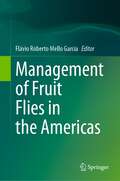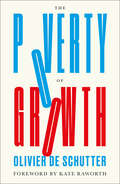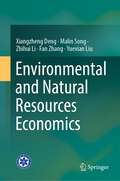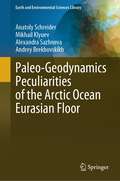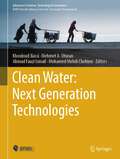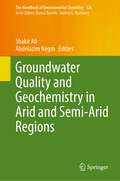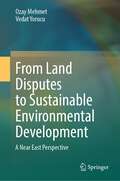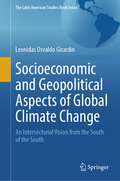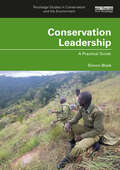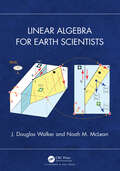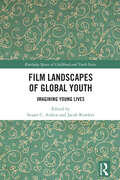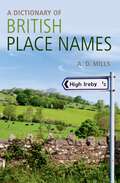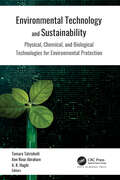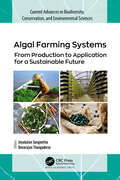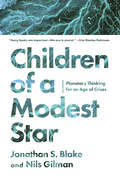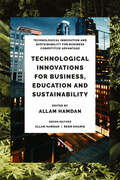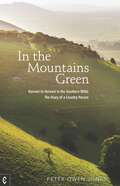- Table View
- List View
Management of Fruit Flies in the Americas
by Flávio Roberto Mello GarciaThis book comprises issues at the cutting edge of fruit fly management in the Americas, covering topics that are focal points of current activity and likely long-term importance to the progress of the field. The book is an invaluable source of ideas and inspiration for entomologists at all levels from graduate students to more-established researchers and professionals. Fruit flies (Diptera, Tephritidae) is the most important pests of fruit production worldwide. The purpose of this book is to integrate the experiences of leading scientists in the management of fruit flies in the Americas. In this work, species of fruit flies of economic importance are considered in the genera Anastrepha, Rhagoletis, Bactrocera, and Ceratitis. This book will address fruit flies monitoring, biological control, chemical control, cultural control, sterile insect technique (SIT), Integrated Pest Management (IPM), and other control methods. The book provides invaluable resource material to scientists, professionals and students.
The Poverty of Growth
by Olivier De Schutter‘Lucid, calm and compelling – Olivier De Schutter tackles the big question – how do we move forward from outdated economic thinking to a sustainable prosperity for all?’ Kate Pickett, co-author, The Spirit Level: Why Equality is Better for EveryoneHow do we combat poverty and rising inequality? In our age of impending climate catastrophe, the conventional wisdom around economic growth is no longer fit for purpose; a rising tide sinks all boats.Oliver De Schutter believes that we must fundamentally rethink the fight against poverty. The quest for growth not only clashes with the need to remain within planetary boundaries, but also creates the very social exclusion it is intended to cure: eroding human rights, widening inequality, and modernising poverty without eliminating it.The Poverty of Growth is a clarion call to forge a new path demanding progress that is no longer focused on wealth and profit.Olivier De Schutter is the United Nations Special Rapporteur on extreme poverty and human rights. Previously, he has been the UN Special Rapporteur on the right to food, and a member of the UN Committee on Economic, Social and Cultural Rights. He is the co-author of The Escape from Poverty and Social Innovation in the Service of Ecological and Social Transformation: The Rise of the Enabling State.
Environmental and Natural Resources Economics
by Xiangzheng Deng Malin Song Zhihui Li Fan Zhang Yuexian LiuThis book aims to integrate multiple disciplinary such as management, economics, and geography from the perspective of resource science and also to strengthen research on resource management to promote sustainability in natural resources. It established clear definition of natural resources and in-depth exploration of main fields such as water resources, land resources, and agricultural resources. Classic methods of economics are applied to solve the problems of resource consumption, environmental pollution, and climate change in modern society. On the basis of classical economics, the disciplinary system of environmental and natural resources is further developed. It is a helpful reference for readers to further study natural resources and environmental economics.
Paleo-Geodynamics Peculiarities of the Arctic Ocean Eurasian Floor (Earth and Environmental Sciences Library)
by Anatoly Schreider Mikhail Klyuev Alexandra Sazhneva Andrey BrekhovskikhThe book deals with some issues of paleo-geodynamics of the Eurasian floor of the Arctic Ocean.A comprehensive geological and geophysical analysis of information on the anomalous magnetic field in the Eurasian Basin was carried out using modeling of the inversion magnetically active layer of the oceanic crust. As a result of this analysis, the identification and spatial position of linear paleo-magnetic anomalies were refined, which made it possible to significantly update the geochronology of the bottom of the Eurasian Basin and identify a number of stages in its evolution.On this basis, the features and stages of the kinematics of the development of the bottom of the Eurasian Basin in the past were revealed.At the first Cretaceous–Paleogene stage, prior to the formation of the A26 paleo-anomaly on the Eurasian margin, extension processes developed significantly and turned into rifting. In the process of rifting, weakened zones and related fractures were formed, along which the Siberian continental margin began to be torn off about 60 Ma ago with the formation of the Lomonosov Ridge.At the second stage of evolution, rifting turned into spreading, and the growth rate of the new oceanic crust in the A26–A24 paleo-anomaly interval (59–53 Ma ago) was more than 2.5 cm/yr. At the same time, the northern flank of the Mid-Arctic Ridge grew more intensively than the southern one.The third stage was characterized by a further progressive slowdown in the process of bottom spreading, the minimum of which, with spreading rates of about 1 cm/year, fell on the formation of paleo-anomalies A13-A6 (30-20 million years ago).The fourth stage of growth of the new oceanic crust began later than the time of the A6 paleo-anomaly and is characterized by some intensification of growth at rates up to 1.2 cm/yr. The average rate of bottom growth over an interval of almost 60 Ma turned out to be close to 1.3 cm/yr, which makes it possible to classify the Mid-Arctic Ridge as a slow-growing one.On this basis, kinematic models of the development of bottom configurations were developed with the determination of the Euler poles, rotation angles, asymmetries, axes of spallation and paleo-bathymetry for the Eurasian Basin, the Polar part of the Lomonosov Ridge, the splitting of the Arlis Spura from the Lomonosov Ridge, the development of the Gakkel Ridge and the development of the Greenland region of the bottom.
Clean Water: Next Generation Technologies (Advances in Science, Technology & Innovation)
by Khouloud Jlassi Mehmet A. Oturan Ahmad Fauzi Ismail Mohamed Mehdi ChehimiThis book summarises the recent, and future, sustainable, low-cost, environment-friendly and efficient systems for clean water production, to solve clean water crisis. We cover production of water the dew and rain or via desalination, Fenton processes or electrocoagulation; nanomaterial-based water purification methods including adsorption, catalysis, smart-sensors for pollutants detection and removal. We also cover environmental management, environmental policy aspects, and review recent patents and industrial processes to produce clean water. Written by experts in the domain of wastewater treatment, production of clean water and environmental management, this new book will be a unique tool for experts and students. We anticipate it open new horizons in clean water production and will be a source of inspiration for next generations of clean water technologies researchers
Groundwater Quality and Geochemistry in Arid and Semi-Arid Regions (The Handbook of Environmental Chemistry #126)
by Shakir Ali Abdelazim NegmThis book reviews groundwater quality and its major global contaminants, and collects the latest advances in the analysis, remediation, risk assessment, and hydrogeochemistry of groundwater in countries such as Algeria, Egypt, Ghana, Kazakhstan, Morocco, Saudi Arabia, and the USA. This book mainly focuses on the major arid and semi-arid areas where groundwater is scarce and highly polluted with geogenic and anthropogenic contaminants and the recharge to the groundwater is negligible due to limited rainfall. Divided into 2 parts, the book starts by covering topics like assessment and protection of groundwater in arid and semi-arid regions, groundwater pollution, and contamination risk assessment. Particular attention is given to the application of environmental isotopes in groundwater studies and how anthropogenic activities impact groundwater quality, the impact of irrigation reservoirs in groundwater and soil quality, and how artificial intelligence is applied to forecast groundwater quality. In the second part of this book, readers will find more about the major global contaminants of groundwater in arid and semi-arid areas, including a geochemical analysis of fluoride and nitrate contamination. Supported by regional case studies, this book appeals to researchers, scholars, and professionals working in the field of groundwater contamination and remediation and is also an important account for policymakers.
From Land Disputes to Sustainable Environmental Development: A Near East Perspective
by Ozay Mehmet Vedat YorucuThis book is written to transform land disputes toward win-win outcomes utilizing the latest sustainable development theory. Land has always been a source of conflict, a contest of competing homelands and ideologies, but it can also act as an agency of peace-making, promoting economic and social development. This dualism will be the theme of this book as there is a dearth of studies exclusively focused on land. The book's coverage is comprehensive, examining land and property disputes with case studies in modern times along with a problem-solving approach utilizing such economic theorems as Location and Growth Poles theories. The UN’s Sustainable Development Goals will be used as our over-arching framework. The overall aim of the book is to transform land disputes toward win-win outcomes utilizing latest sustainable development theory.
Socioeconomic and Geopolitical Aspects of Global Climate Change: An Intersectorial Vision from the South of the South (The Latin American Studies Book Series)
by Leonidas Osvaldo GirardinThis book discusses climate change from an academic point of view centered on and from Latin America. Although climate change is a global issue, there has been a notable lack of input from the Latin American perspective, which means that many Latin American intellectuals often bring ideas, tools and potential solutions proposed by external, international research centers or organizations to the region. This book embraces a Latin American viewpoint to critically engage the problem and many of the concepts used in the analysis of climate change.The text emphasizes heterogeneity as an essential factor that cannot be absent in the analysis of how to understand and face the challenges posed by climate change. This heterogeneity refers not only to the magnitude of the impact that different regions will experience (including in their productive activities, ecosystems and social groups), but also to their contexts and capacities. Different countries' and regions' historical accumulated emissions—the primary cause of the current atmospheric concentrations of greenhouse gases—can inform current responsibilities, and their diverse productive structures will also contribute to different baselines in energy, agriculture and other sectors. Asymmetries in economic, technological and political capacities to face climate-related challenges will influence the social and economic costs of potential adaptation and mitigation measures.Using this conceptual approach, the book focuses on some of the main climate change-linked impacts expected in the region, such as effects on semi-arid ecosystems, and feasible, sector-specific adaptation measures. Furthermore, it contextualizes mitigation measures that appear on the international agenda (including the utilization of economic instruments to flexibilize the fulfillment of climate commitments) in the Latin American region.Socioeconomic and Geopolitical Aspects of Global Climate Change: An Intersectorial Vision from the South of the South offers socioeconomic and geopolitical analysis from the perspective of a region that is going to suffer impacts disproportionately greater than its historical and current responsibility in triggering this global environmental threat.
Conservation Leadership: A Practical Guide (Routledge Studies in Conservation and the Environment)
by Simon BlackThis book is an important guide for individuals seeking to develop and grow their leadership skills in the wildlife conservation sector, across varied disciplines such as environmental management, conservation biology, and ecotourism.Conservation Leadership addresses what leadership is, why it is important, and how to be an effective leader. It identifies the common pitfalls or mistakes in a leader’s thinking or behaviour, and the unexpected consequences or responses which can arise, and then explores more helpful alternative approaches to leadership. The book is divided into three parts: Part I: Leadership principles Part II: Four areas of profound theory: knowledge, psychology, systems, and variation Part III: Skills and competencies for conservation leaders It focuses on contextual and organisational challenges in conservation, including limited resources, remote locations, fragile species of concern, politics, community conflict, crime, and commercial pressures. The scope is global, using diverse examples such as sea turtle head-starting in South Asia, reforestation in North Africa, bird conservation in North America, human–wildlife interactions in the Himalayas, and post-colonial issues in the Caribbean. Case studies illustrate key learning points from small local teams through to global transnational initiatives. Exercises in each chapter enable the exploration of less-familiar topics, including interpersonal skills, goal setting and performance measurement, plus a unique research-derived conservation leadership self-assessment tool.This book is an essential reading resource for professionals and senior leaders in the wildlife management and conservation sector, as well as students on biodiversity conservation, wildlife conservation, and environmental management courses.
Conservation Leadership: A Practical Guide (Routledge Studies in Conservation and the Environment)
by Simon BlackThis book is an important guide for individuals seeking to develop and grow their leadership skills in the wildlife conservation sector, across varied disciplines such as environmental management, conservation biology, and ecotourism.Conservation Leadership addresses what leadership is, why it is important, and how to be an effective leader. It identifies the common pitfalls or mistakes in a leader’s thinking or behaviour, and the unexpected consequences or responses which can arise, and then explores more helpful alternative approaches to leadership. The book is divided into three parts: Part I: Leadership principles Part II: Four areas of profound theory: knowledge, psychology, systems, and variation Part III: Skills and competencies for conservation leaders It focuses on contextual and organisational challenges in conservation, including limited resources, remote locations, fragile species of concern, politics, community conflict, crime, and commercial pressures. The scope is global, using diverse examples such as sea turtle head-starting in South Asia, reforestation in North Africa, bird conservation in North America, human–wildlife interactions in the Himalayas, and post-colonial issues in the Caribbean. Case studies illustrate key learning points from small local teams through to global transnational initiatives. Exercises in each chapter enable the exploration of less-familiar topics, including interpersonal skills, goal setting and performance measurement, plus a unique research-derived conservation leadership self-assessment tool.This book is an essential reading resource for professionals and senior leaders in the wildlife management and conservation sector, as well as students on biodiversity conservation, wildlife conservation, and environmental management courses.
Linear Algebra for Earth Scientists
by J. Douglas Walker Noah M. McLeanLinear Algebra for Earth Scientists is written for undergraduate and graduate students in Earth and Environmental sciences. It is intended to give students enough background in linear algebra to work with systems of equations and data in geology, hydrology, geophysics, or whatever part of the Earth Sciences they engage with.The book does not presuppose any extensive prior knowledge of linear algebra. Instead, the book builds students up from a low base to a working understanding of the sub t that they can apply to their work, using many familiar examples in the geosciences.Features Suitable for students of Earth and Environmental Sciences Minimal prerequisites — written in a way that is accessible and engaging for those without a mathematical background All material presented with examples and applications to the Earth Sciences
Linear Algebra for Earth Scientists
by J. Douglas Walker Noah M. McLeanLinear Algebra for Earth Scientists is written for undergraduate and graduate students in Earth and Environmental sciences. It is intended to give students enough background in linear algebra to work with systems of equations and data in geology, hydrology, geophysics, or whatever part of the Earth Sciences they engage with.The book does not presuppose any extensive prior knowledge of linear algebra. Instead, the book builds students up from a low base to a working understanding of the sub t that they can apply to their work, using many familiar examples in the geosciences.Features Suitable for students of Earth and Environmental Sciences Minimal prerequisites — written in a way that is accessible and engaging for those without a mathematical background All material presented with examples and applications to the Earth Sciences
Film Landscapes of Global Youth: Imagining Young Lives (Routledge Spaces of Childhood and Youth Series)
This book explores the dynamic landscapes of global youth through spatially grounded chapters focused on film and media. It is a collection of incredible works concerning children and young people in, out, and through media as well as an examination of what is possible for the future of research within the intersections of geography, film theory, and children’s studies.It contains contributions from leading academics from anthropology, sociology, philosophy, art, film and media studies, women and gender studies, Indigenous studies, education, and geography, with chapters focused on a spatial area and the representations and relationships of children in that area through film and media. The insights presented also provide a unique and eclectic perspective on the current state of children’s research in relation to the ever-changing media landscape of the 21st century. Film Landscapes of Global Youth approaches the subjects of children and young people in film and media in a way that is not bound by genre, format, medium, or the on-/off-screen binary. Each chapter offers an insightful look at the relationships and portrayals of children and young people in relation to a specific country, culture, or geographic feature.This book is a must-read for anyone interested in the intersections between geography, young lives, and the power of film, television, social media, content creation, and more.
Film Landscapes of Global Youth: Imagining Young Lives (Routledge Spaces of Childhood and Youth Series)
by Stuart C. Aitken Jacob RowlettThis book explores the dynamic landscapes of global youth through spatially grounded chapters focused on film and media. It is a collection of incredible works concerning children and young people in, out, and through media as well as an examination of what is possible for the future of research within the intersections of geography, film theory, and children’s studies.It contains contributions from leading academics from anthropology, sociology, philosophy, art, film and media studies, women and gender studies, Indigenous studies, education, and geography, with chapters focused on a spatial area and the representations and relationships of children in that area through film and media. The insights presented also provide a unique and eclectic perspective on the current state of children’s research in relation to the ever-changing media landscape of the 21st century. Film Landscapes of Global Youth approaches the subjects of children and young people in film and media in a way that is not bound by genre, format, medium, or the on-/off-screen binary. Each chapter offers an insightful look at the relationships and portrayals of children and young people in relation to a specific country, culture, or geographic feature.This book is a must-read for anyone interested in the intersections between geography, young lives, and the power of film, television, social media, content creation, and more.
A Dictionary of British Place-Names (Oxford Quick Reference)
This revised edition of the Dictionary of British Place-Names includes over 17,000 engaging and informative entries, tracing the development of the featured place-names from earliest times to the present day. Included place-names range from the familiar to the obscure, among them 'Beer', 'Findlater', 'Broadbottom', and 'Great Snoring'. The A to Z entries are complemented by a detailed introductory essay discussing the chronology and development of English, Irish, Welsh, and Scottish place-names, as well as an extensive bibliography, maps of Britain showing old and new boundaries, and a glossary of common elements in place-names. Also new to this edition is an appendix of recommended web links pointing to relevant online resources, thereby expanding the scope of the dictionary and providing the reader with an opportunity to explore the subject further. Both accessible and up to date, this dictionary is an ideal companion for anybody travelling around the British Isles, as well as for researchers and students with an interest in toponomy, local history, cartography, and lexicography.
A Dictionary of British Place-Names (Oxford Quick Reference)
by A. D. MillsThis revised edition of the Dictionary of British Place-Names includes over 17,000 engaging and informative entries, tracing the development of the featured place-names from earliest times to the present day. Included place-names range from the familiar to the obscure, among them 'Beer', 'Findlater', 'Broadbottom', and 'Great Snoring'. The A to Z entries are complemented by a detailed introductory essay discussing the chronology and development of English, Irish, Welsh, and Scottish place-names, as well as an extensive bibliography, maps of Britain showing old and new boundaries, and a glossary of common elements in place-names. Also new to this edition is an appendix of recommended web links pointing to relevant online resources, thereby expanding the scope of the dictionary and providing the reader with an opportunity to explore the subject further. Both accessible and up to date, this dictionary is an ideal companion for anybody travelling around the British Isles, as well as for researchers and students with an interest in toponomy, local history, cartography, and lexicography.
Environmental Technology and Sustainability: Physical, Chemical and Biological Technologies for Environmental Protection
by Tamara Tatrishvili Ann Rose Abraham A. K. HaghiThis new title covers the most recent theoretical and practical advancements in green technology for a clean and healthy environment. It aims to provide a better understanding of the research and development of new technologies that are becoming increasingly important for ensuring sustainability.The book provides vital information on advanced materials and green composites and expounds on environmental chemistry for a sustainable world, focusing on different characterization methods as well as new techniques. The volume also considers recent developments and applications of clean energy materials. It presents case studies that emphasize the green technologies being discussed.
Algal Farming Systems: From Production to Application for a Sustainable Future (Current Advances in Biodiversity, Conservation, and Environmental Sciences)
by Jeyabalan Sangeetha Devarajan ThangaduraiThe farming and cultivation of algae can provide sustainable solutions for issues like food security-related problems, costly health-related products, sustainable fuels, and more. However, the use of algae is currently restricted to high-value, low-volume markets, mainly due to the high investment and production costs involved. In recent years, algaculture for food and fuel purposes has begun a transition from R&D and pilot-scale operations to commercial-scale systems. This new book presents the latest technological innovations in algae production, market status, and prospects for algal applications.The book provides an informative overview of different perspectives on the commercial production of algae-based food, health, and high-value cosmeceutical products, providing an institutional framework to support and promote the development and commercialization of algal farming. The book discusses phycotechnology and highlights the current trends and future scope of algal technology. It also presents new information on algal culture conditions and cultivation strategies, including a look at geographic position and local climate as key factors in the implementation of microalgae-based processes. Algal production, marketing strategies, and their commercialization are discussed, as are the industrial applications of algae, focusing mainly on nutraceutical, pharmaceutical, and cosmeceutical applications of microalgae and macroalgae.
Algal Farming Systems: From Production to Application for a Sustainable Future (Current Advances in Biodiversity, Conservation, and Environmental Sciences)
The farming and cultivation of algae can provide sustainable solutions for issues like food security-related problems, costly health-related products, sustainable fuels, and more. However, the use of algae is currently restricted to high-value, low-volume markets, mainly due to the high investment and production costs involved. In recent years, algaculture for food and fuel purposes has begun a transition from R&D and pilot-scale operations to commercial-scale systems. This new book presents the latest technological innovations in algae production, market status, and prospects for algal applications.The book provides an informative overview of different perspectives on the commercial production of algae-based food, health, and high-value cosmeceutical products, providing an institutional framework to support and promote the development and commercialization of algal farming. The book discusses phycotechnology and highlights the current trends and future scope of algal technology. It also presents new information on algal culture conditions and cultivation strategies, including a look at geographic position and local climate as key factors in the implementation of microalgae-based processes. Algal production, marketing strategies, and their commercialization are discussed, as are the industrial applications of algae, focusing mainly on nutraceutical, pharmaceutical, and cosmeceutical applications of microalgae and macroalgae.
Environmental Technology and Sustainability: Physical, Chemical and Biological Technologies for Environmental Protection
This new title covers the most recent theoretical and practical advancements in green technology for a clean and healthy environment. It aims to provide a better understanding of the research and development of new technologies that are becoming increasingly important for ensuring sustainability.The book provides vital information on advanced materials and green composites and expounds on environmental chemistry for a sustainable world, focusing on different characterization methods as well as new techniques. The volume also considers recent developments and applications of clean energy materials. It presents case studies that emphasize the green technologies being discussed.
Children of a Modest Star: Planetary Thinking for an Age of Crises
by Jonathan S. Blake Nils GilmanA clear-eyed and urgent vision for a new system of political governance to manage planetary issues and their local consequences. Deadly viruses, climate-changing carbon molecules, and harmful pollutants cross the globe unimpeded by national borders. While the consequences of these flows range across scales, from the planetary to the local, the authority and resources to manage them are concentrated mainly at one level: the nation-state. This profound mismatch between the scale of planetary challenges and the institutions tasked with governing them is leading to cascading systemic failures. In the groundbreaking Children of a Modest Star, Jonathan S. Blake and Nils Gilman not only challenge dominant ways of thinking about humanity's relationship to the planet and the political forms that presently govern it, but also present a new, innovative framework that corresponds to our inherently planetary condition. Drawing on intellectual history, political philosophy, and the holistic findings of Earth system science, Blake and Gilman argue that it is essential to reimagine our governing institutions in light of the fact that we can only thrive if the multi-species ecosystems we inhabit are also flourishing. Aware of the interlocking challenges we face, it is no longer adequate merely to critique our existing systems or the modernist assumptions that helped create them. Blake and Gilman propose a bold, original architecture for global governance—what they call planetary subsidiarity—designed to enable the enduring habitability of the Earth for humans and non-humans alike. Children of a Modest Star offers a clear-eyed and urgent vision for constructing a system capable of stabilizing a planet in crisis.
Children of a Modest Star: Planetary Thinking for an Age of Crises
by Jonathan S. Blake Nils GilmanA clear-eyed and urgent vision for a new system of political governance to manage planetary issues and their local consequences. Deadly viruses, climate-changing carbon molecules, and harmful pollutants cross the globe unimpeded by national borders. While the consequences of these flows range across scales, from the planetary to the local, the authority and resources to manage them are concentrated mainly at one level: the nation-state. This profound mismatch between the scale of planetary challenges and the institutions tasked with governing them is leading to cascading systemic failures. In the groundbreaking Children of a Modest Star, Jonathan S. Blake and Nils Gilman not only challenge dominant ways of thinking about humanity's relationship to the planet and the political forms that presently govern it, but also present a new, innovative framework that corresponds to our inherently planetary condition. Drawing on intellectual history, political philosophy, and the holistic findings of Earth system science, Blake and Gilman argue that it is essential to reimagine our governing institutions in light of the fact that we can only thrive if the multi-species ecosystems we inhabit are also flourishing. Aware of the interlocking challenges we face, it is no longer adequate merely to critique our existing systems or the modernist assumptions that helped create them. Blake and Gilman propose a bold, original architecture for global governance—what they call planetary subsidiarity—designed to enable the enduring habitability of the Earth for humans and non-humans alike. Children of a Modest Star offers a clear-eyed and urgent vision for constructing a system capable of stabilizing a planet in crisis.
Technological Innovations for Business, Education and Sustainability (Technological Innovation and Sustainability for Business Competitive Advantage)
by Allam Hamdan Reem KhamisAwareness of the essential skills required for thriving in the job market is necessary for educators and employers. Shedding light on the role of industry in promoting work-based learning, Technological Innovations for Business and Education Sustainability considers how technology has both transformed the business landscape, and how it might continue to do so in future. Harnessing the potential of innovative Industry 4.0 technologies such as the Internet of Things (IoT) and Artificial Intelligence (AI) for sustainable business models, contributors rethink core skills required to meet the changing needs of the work environments in terms of modes of education and workplace ethics, as well as the implications of these constantly evolving technologies for employers and workplaces. Chapters analyse in detail how rapidly advancing technologies have already affected recruitment, retail, banking, the oil and gas industry, insurance, financial services, advertising, childhood obesity, human resources and organizational management, small- and medium-sized enterprises (SMEs), cloud computing and more. Fulfilling a growing need for aligning business strategy and educational curriculums with the evolving skills required for business workplaces, Technological Innovations for Business and Education Sustainability presents a thorough understanding of how business, education and technology can enable current and future leaders to contribute positively to the digital transformation currently in play across the globe.
Technological Innovations for Business, Education and Sustainability (Technological Innovation and Sustainability for Business Competitive Advantage)
by Allam Hamdan Reem KhamisAwareness of the essential skills required for thriving in the job market is necessary for educators and employers. Shedding light on the role of industry in promoting work-based learning, Technological Innovations for Business and Education Sustainability considers how technology has both transformed the business landscape, and how it might continue to do so in future. Harnessing the potential of innovative Industry 4.0 technologies such as the Internet of Things (IoT) and Artificial Intelligence (AI) for sustainable business models, contributors rethink core skills required to meet the changing needs of the work environments in terms of modes of education and workplace ethics, as well as the implications of these constantly evolving technologies for employers and workplaces. Chapters analyse in detail how rapidly advancing technologies have already affected recruitment, retail, banking, the oil and gas industry, insurance, financial services, advertising, childhood obesity, human resources and organizational management, small- and medium-sized enterprises (SMEs), cloud computing and more. Fulfilling a growing need for aligning business strategy and educational curriculums with the evolving skills required for business workplaces, Technological Innovations for Business and Education Sustainability presents a thorough understanding of how business, education and technology can enable current and future leaders to contribute positively to the digital transformation currently in play across the globe.
In the Mountains Green: Harvest to Harvest in the Southern Wilds – The Diary of a Country Parson
by Peter Owen Jones'As a boy, I would walk out into the fields alone. Looking south, I set my eyes on the far ridge, wondering, not knowing, what lay beyond it. What world existed there? Now, as a man, I stand on the top of the Downs, up on the mountains green. To the south, the land folds down to the sea, but to the north the boy is there looking back at me…' In a series of joyous, reflective and inspired diary pieces, Peter Owen Jones takes us on a voyage through the yearly cycle – a journey of inner and outer discovery. With the variety and colour of British seasonal life and the beauty of the Sussex countryside as his backdrop, Owen Jones observes the magical in the everyday – in the birds, bees and butterflies, but also in people. With lightness of touch and good humour, he calls for an awakening to the world around us, to ourselves, and ultimately to meaning in life. Originally published as a series of separate articles in Sussex Life magazine, the essays gathered here provide a delightful glimpse into the life of a nature-loving country parson.
